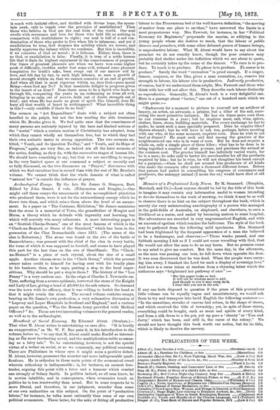Archceological Essays. By the late Sir James G. Simpson, Bart.
Edited by John Stuart. 2 vols. (Edmonston and Douglas.)—One might call these essays the amusement of the accomplished physician who produced them, were it not for the extraordinary energy which he threw into them, and which raises them above the level of an amuse- ment. In a paper on "The Casten°, Kirkliston," Sir James maintains that the stone is a memorial of Vette, the grandfather of Hengist and Horse, a theory which he defends with ingenuity and learning, but which will scarcely win many adherents. A more interesting paper is on "Scottish Charm-Stones," one of the most famous of which is the "Clach-na-Bratard, or Stone of tho Standard," which has been in the possession of the Clan Donnachaidh since 1315. (The name of the clan is Robertson.) The stone was found on the eve of the battle of Bannockburn; was present with the chief of the clan in every battle, the issue of which it was supposed to foretell, and seems to have played this part for the last time on the eve of Sheriffmuir. The " Clach- na-Bratard" is a piece of rock crystal, about the size of a small apple. Another charm-stone is the " Clach Dearg," which the present owner takes credit to himself for having sent with his family plate to his bankers, thus, as he says, putting a stop to the local super- stitions. Why should he put a stop to them ? The history of the "Lee Penny" is a very curious one. In the reign of Charles I. Newcastle-on- Tyne, suffering from a severe epidemic, borrowed the stone of the Knight and Lady of Lee, giving a bond of £6,000 for its safe return. So charmed was the town with its efficacy, that it was willing to forfeit the bond so that it might retain the stone. The second volume contains essays. bearing on Sir James's own profession, a very exhaustive discussion of "Leprosy and Leper Hospitals in Scotland and England," and a curious paper on the question, "Was the Roman Army provided with Medical Officers ? " &c. These are two interesting volumes to the general reader, as well as to the arehmologist.


































 Previous page
Previous page